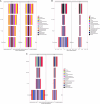Global burden of all cause-specific injuries among children and adolescents from 1990 to 2019: a prospective cohort study
- PMID: 38348839
- PMCID: PMC11020088
- DOI: 10.1097/JS9.0000000000001131
Global burden of all cause-specific injuries among children and adolescents from 1990 to 2019: a prospective cohort study
Abstract
Background: To assess the burden and change in incidence, death, and disability-adjusted life years (DALYs) for all-cause-specific injuries among children and adolescents in 204 countries and territories between 1990 and 2019.
Materials and methods: Data were extracted from the Global Burden of Disease, Injury, and Risk Factor Study 2019 (GBD 2019). Global, regional, and country-level age-standardized rate (per 100 000) of incidence (ASRI), mortality (ASRM), and DALYs (ASRD) with 95% uncertainty interval (95% UI) of injuries were estimated by age, sex, socio-demographic index (SDI), and all-cause-specific injuries from 1990 to 2019.
Results: Overall, the ASRI, ASRM, and ASRD of injury were 9006.18 (95% UI: 7459.74-10 918.04), 23.04 (20.00-26.50), and 2020.19 (1759.47-2318.64) among children and adolescents worldwide in 2019, respectively. All the above indicators showed a downward trend from 1990 to 2019. In level 2 cause of injury, both the global transport injury and unintentional injury declined during the study years, while self-harm and interpersonal violence-related injury showed an increasing trend. High SDI regions had higher ASRI of injuries, but low SDI regions had higher ASRM and ASRD of injuries globally in 2019. Males had a higher burden of injuries than those in females. The ASRI of injuries is higher in adolescents aged 15-19 years, whereas the mortality and DALYs rate are higher among children under 5 years old. Moreover, adolescents aged 15-19 years and individuals living in Central Asia, Middle East, and Africa had higher ASRI, ASRM, and ASRD of injuries owing to self-harm and interpersonal violence. Generally, falls and road traffic injuries are the leading cause of injury among the population aged 0-19 years worldwide, but self-harm, interpersonal violence, and conflict and terrorism are also leading types of injuries in some regions, particularly in Low-Income Countries and Middle-Income Countries.
Conclusions: Injury remains a major global public health problem among children and adolescents, although its burden at the worldwide level showed a decreasing trend from 1990 to 2019. Of concern, the burden of injuries caused by transport injuries, and unintentional injuries has shown a downward trend in most countries, while the burden caused by self-harm and interpersonal violence has shown an upward trend in most countries. These findings suggest that more targeted and specific strategies to prevent the burden of injuries should be reoriented, and our study provides important findings for decision-makers and healthcare providers to reduce injury burden among children and adolescents.
Copyright © 2024 The Author(s). Published by Wolters Kluwer Health, Inc.
Conflict of interest statement
The author declares no conflict of interest.
Sponsorships or competing interests that may be relevant to content are disclosed at the end of this article.
Figures





Similar articles
-
Global, regional, and national burdens of road injuries from 1990 to 2021: Findings from the 2021 Global Burden of Disease Study.Injury. 2025 Mar;56(3):112221. doi: 10.1016/j.injury.2025.112221. Epub 2025 Feb 16. Injury. 2025. PMID: 39978035
-
Global, regional, and national total burden related to hepatitis B in children and adolescents from 1990 to 2021.BMC Public Health. 2024 Oct 23;24(1):2936. doi: 10.1186/s12889-024-20462-4. BMC Public Health. 2024. PMID: 39443929 Free PMC article.
-
Global, regional, and national burden and trends of air pollution-related neoplasms from 1990 to 2019: An observational trend study from the Global Burden of Disease Study 2019.Ecotoxicol Environ Saf. 2024 Oct 15;285:117068. doi: 10.1016/j.ecoenv.2024.117068. Epub 2024 Sep 24. Ecotoxicol Environ Saf. 2024. PMID: 39321528
-
Global, regional, and national burden of 12 mental disorders in 204 countries and territories, 1990-2019: a systematic analysis for the Global Burden of Disease Study 2019.Lancet Psychiatry. 2022 Feb;9(2):137-150. doi: 10.1016/S2215-0366(21)00395-3. Epub 2022 Jan 10. Lancet Psychiatry. 2022. PMID: 35026139 Free PMC article.
-
The burden of injuries in Ethiopia from 1990-2017: evidence from the global burden of disease study.Inj Epidemiol. 2020 Dec 21;7(1):67. doi: 10.1186/s40621-020-00292-9. Inj Epidemiol. 2020. PMID: 33342441 Free PMC article. Review.
Cited by
-
The Diagnosis and Management of Pediatric Blunt Abdominal Trauma-A Comprehensive Review.Diagnostics (Basel). 2024 Oct 10;14(20):2257. doi: 10.3390/diagnostics14202257. Diagnostics (Basel). 2024. PMID: 39451580 Free PMC article. Review.
-
Global burden of drowning and risk factors across 204 countries from 1990 to 2021.Sci Rep. 2025 Mar 29;15(1):10916. doi: 10.1038/s41598-025-95486-w. Sci Rep. 2025. PMID: 40158004 Free PMC article.
-
The global burden of fractures and its underlying etiologies: results from and further analysis of the Global Burden of Disease Study 2021.Arch Osteoporos. 2025 Aug 6;20(1):111. doi: 10.1007/s11657-025-01596-3. Arch Osteoporos. 2025. PMID: 40764873
-
Epidemiological and clinical characteristics of hospitalized unintentional injuries among children in central China from 2017-2023.Front Pediatr. 2024 May 23;12:1381287. doi: 10.3389/fped.2024.1381287. eCollection 2024. Front Pediatr. 2024. PMID: 38846330 Free PMC article.
-
Exploring pediatric palliative care in Luxembourg: a mixed-methods study.BMC Palliat Care. 2025 Jul 1;24(1):170. doi: 10.1186/s12904-025-01813-3. BMC Palliat Care. 2025. PMID: 40597053 Free PMC article.
References
-
- World Health Organization , Global health estimates: Leading causes of death, https://www.who.int/data/gho/data/themes/mortality-and-global-health-est...
-
- Krug EG. World Health Organization,Violence and Injury Prevention Team, Injury : a leading cause of the global burden of disease. World Health Organization; 1999.
-
- Rivara FP. Prevention of death and disability from injuries to children and adolescents. Int J Injury Control Safety Prom 2012;19:226–230. - PubMed
MeSH terms
LinkOut - more resources
Full Text Sources
Medical

